 Employee Communication Best Practices
Employee Communication Best Practices
Learn how to use employee resource group's best practices that will succeed, flourish, and deliver lasting impact. They can play a powerful.
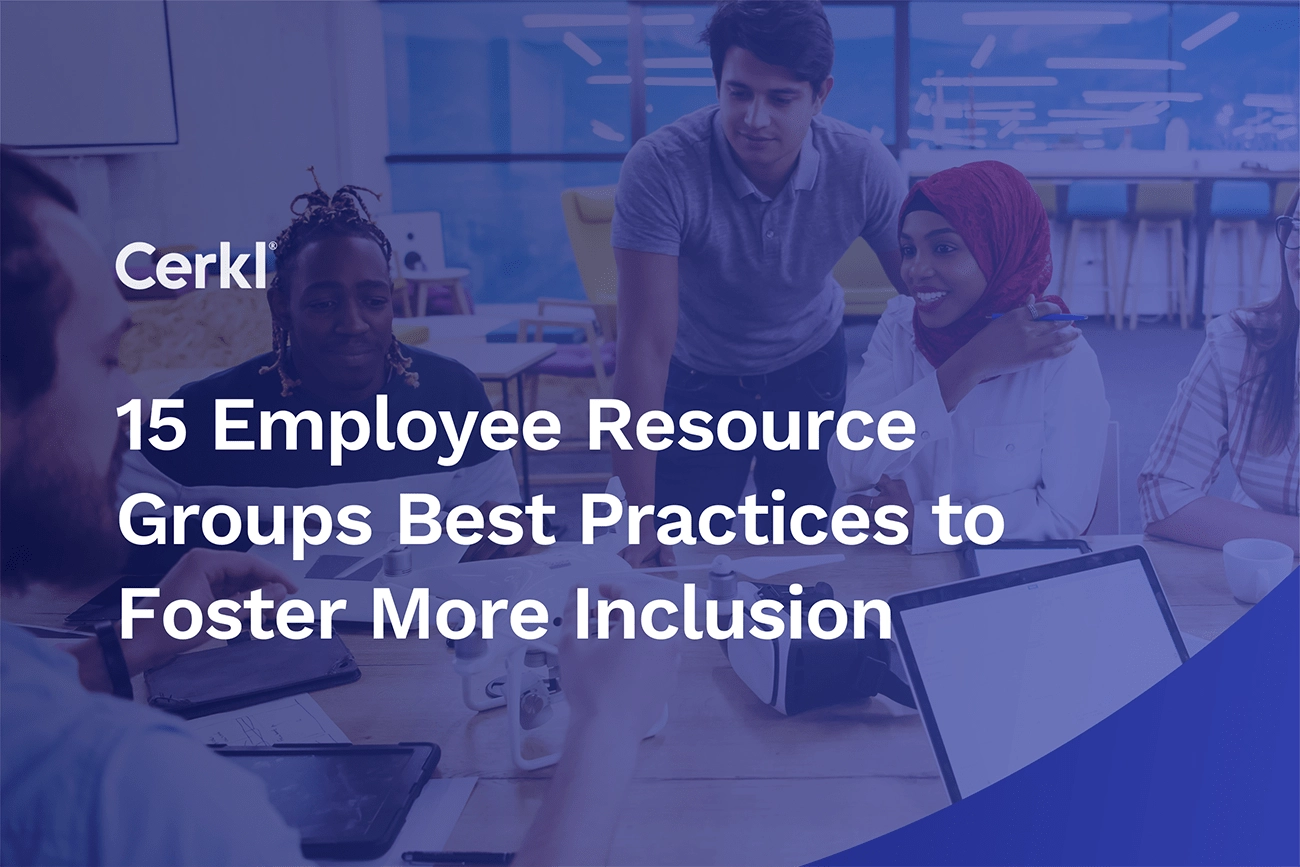
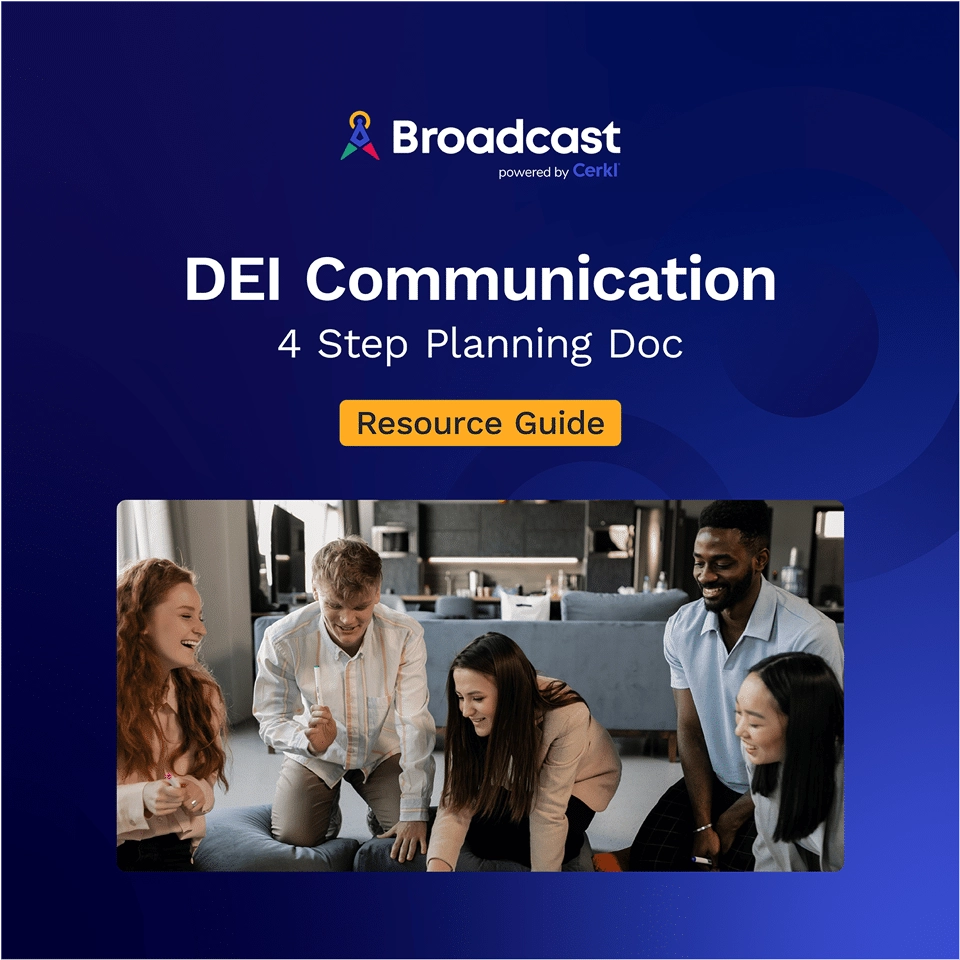
Communications around Diversity, Equity, and Inclusion (DEI) need to be strategic, thoughtful, and empathetic. Ensure your DEI communications are up to standards with our 4 step planning document.
Access NowEmployee resource groups (ERGs) play a vital role in fostering diversity, equity, and inclusion (DEI) within a company. These groups, formed by employees with shared backgrounds or experiences, create a vital space for connection, support, and advocacy.
While not driven by internal communicators, ERGs not only provide a sense of belonging and support for members, but they also serve as valuable resources for the entire organization. Implementing employee resource groups best practices involves ensuring leadership support, establishing clear goals and objectives, promoting active participation, and fostering collaboration and allyship. Employee resource groups engage in a wide range of employee resource group activities, such as organizing workshops, cultural celebrations, mentoring programs, and community outreach initiatives. All of these are aimed at promoting diversity, equity, and inclusivity in the workplace and beyond.
But, the reality is that they are often not properly utilized. According to Gallagher’s State of the Sector 2023/24 report, only 26% of organizations are using them (a 3% increase from the previous year). However, they are still perceived as effective employee listening tools, with 70% of respondents agreeing. As a collaboration and interpersonal channel the usage of Employee resource groups increased by 8% in 2024. While 51% of respondents confirmed using them, 88% reported that they are effective.
That’s a good start, but it is clear that simply establishing an employee resource group isn't enough. To ensure it thrives and delivers lasting impact, we need to go beyond the initial formation and offer value.
This post details best practices for employee resource groups. It also suggests best practices for employee resource group events and activities. Get started to learn more about how you can encourage employees to establish their own employee resource groups. You may be surprised just how much they can help you increase employee engagement.
Ensure your company's communications promote diversity, equity, and inclusion

A caveat here is that internal communicators don’t own — and shouldn’t ever try to hijack — any employee resource group. These groups are set up by employees. All an internal communicator should do is to partner with group admins and help them to communicate organization messages. You cannot dictate to them, but you can be helpful. Form a good relationship and you will all benefit from it.
What we have done here is to detail 15 best practices and spread them through three key stages:
By implementing these practices, you can empower your employee resource groups to become a driving force for inclusion within your organization. This, in turn, will foster a more diverse, equitable, and successful workplace for everyone.
A thriving employee resource group starts with a solid foundation. So, let’s explore best practices you can follow to establish a clear purpose, secure leadership support, and foster inclusivity within ERGs.
A strong employee resource group starts with a well-defined purpose that aligns with the company's overall mission and values.
Alveda J. Williams, a scientist turned resources professional, talks about finding “a north star” that will make ERGs feel connected to the greater purpose of the company. The chief inclusion officer at Dow, she emphasizes that ERGs are a great resource for companies, even though they are intended to be a resource for employees.
At Dow, she says, ERGs are embedded in the diversity and inclusion (D&I) governance structure. As such, they participate in strategic councils. Furthermore, more than half of the company’s employees participate in at least one employee resource group.
“ERGs are a perfect place to get the voice of the employee. They provide an opportunity to gather market information, market research, and also drive company priorities.”
Alveda J. Williams
Leadership buy-in is crucial for an ERG's success. Secure commitment from senior leaders through active participation in ERG activities, advocating for the group's initiatives, and providing ongoing support. This demonstrates the company's dedication to DEI and empowers the ERG to make a real difference.
ERG leadership compensation is on the rise. The most recent annual survey conducted by The Rise Journey reveals that in 2020, only 6% of leaders received any form of compensation. This number skyrocketed to 46% by 2022, with the average employee resource group leader receiving $2,136 annually. This trend indicates growing recognition of the time and effort ERG leaders contribute.
While employee resource groups often focus on specific under-represented groups, inclusivity is key. It is crucial to encourage participation from all employees, regardless of background or identity. This fosters a sense of belonging, creates a richer learning environment, and allows the ERG to address a wider range of experience.
Working from an isolated work from home environment, employees often miss their in-depth office talks with friends and colleagues and summertime cultural events. Virtual ERGs help create a strong company culture by bringing people together and offering fresh ideas. They also improve employee satisfaction and loyalty, and boost the company's image by cultivating passionate brand ambassadors. To be successful, ERGs need support from leaders who work closely with group leaders to set goals.
Your company’s D&I department (or leadership serving in this function) should create objectives, roles, and responsibilities for how the ERG should operate. This includes outreach to top performers who have a passion for leadership. It’s also important that an ERG has clear documented direction on how to plan and coordinate with facilities, internal communications, and finance departments.
Equip ERG leaders with the knowledge and tools they need to effectively manage the group. Provide leadership training on topics like group facilitation, communication strategies, event planning, budgeting, and conflict resolution. Consider mentorship programs or peer learning opportunities to foster ongoing development.
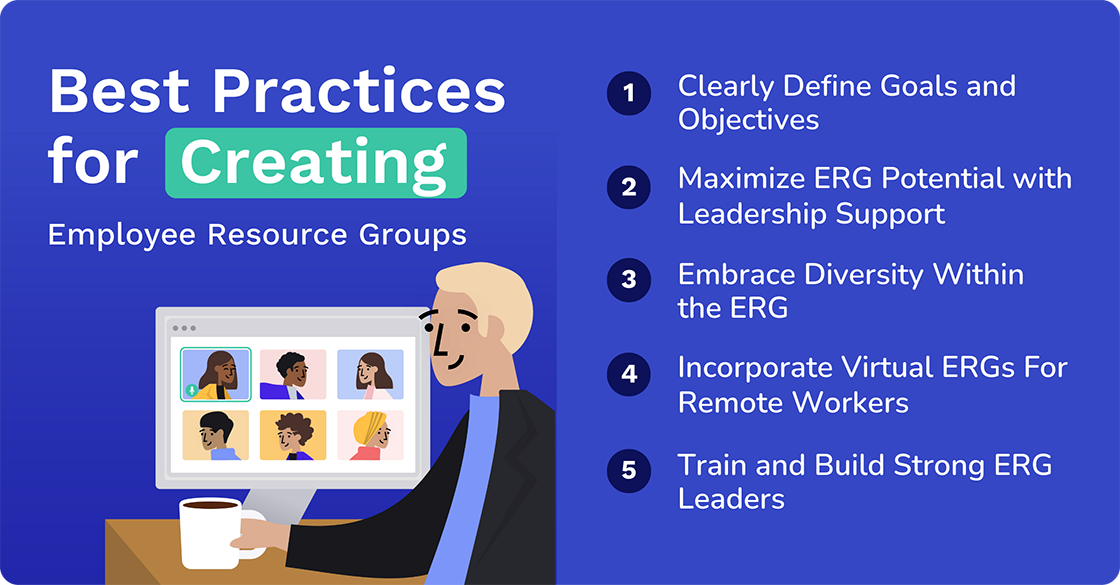
Once established, effective management is crucial for the ongoing success of an employee resource group. This section dives into best practices for measuring progress, training leaders, and fostering communication and employee engagement among ERG members.
It is essential to define clear metrics to track the progress and impact of ERGs. Consider metrics like membership growth, event participation rates, and member satisfaction surveys. Be sure to include diversity demographics including race and gender within the ERG. Tracking these demographics provides valuable insights into the composition of the group and helps identify any disparities or areas where additional support may be needed.
An interesting article published by McKinsey & Company states that by aligning their work with both employee and corporate expectations, ERGs can help people feel more included in the workplace. Metrics play an important role in assessing the impact of programs and initiatives — “outlining how ERGs benefit employees, the organization, and potentially the community, depending on ERG goals.”
Ensure your company's communications promote diversity, equity, and inclusion

#7 Promote Internal and External Engagement
Encourage collaboration within the company. ERGs can partner with other departments on initiatives and co-host events. Look for opportunities to connect with external organizations that are relevant to the employee resource group’s focus. It also broadens the ERG's reach, allows for knowledge sharing, and will strengthen the company's reputation as a DEI leader.
Maintain open and consistent communication channels with ERG members. Utilize a mix of communication methods like newsletters, internal social media platforms, and ERG-specific websites or forums to keep members informed about upcoming events. These can also be used to share resources and encourage participation.
Employee resource groups can organize events that address member interests and create a sense of community. Consider a mix of professional development workshops, networking events, social gatherings, cultural celebrations, or mentorship programs. Encourage member participation in planning events to ensure they are relevant and engaging.
Regularly gather feedback from members through surveys, focus groups, or one-on-one conversations. Be sure to understand their needs, concerns, and suggestions to ensure the ERG remains relevant and addresses their evolving priorities.

A strong ERG can significantly impact your company culture. In this section, we'll explore best practices to strategically align your ERG with business goals, offer professional development opportunities, and broaden your reach through community outreach.
Ensure the ERG's goals are strategically aligned with the company's broader objectives. This creates a win-win situation. The ERG's initiatives can support business goals including talent acquisition, retention, or innovation, while the company's resources and support empower the ERG to make a lasting impact.
Offer professional development opportunities for members. This could include workshops on career advancement, mentorship programs connecting members with experienced professionals, or speaker events featuring industry leaders. Investing in member development strengthens the talent pool and demonstrates the company's commitment to employee growth.
Consider partnering with external organizations relevant to an ERG's focus. This could involve volunteering, co-hosting events, or participating in community initiatives. Community outreach allows an ERG to make a broader impact, build positive relationships, and enhance the company's social responsibility efforts.
Recognize and celebrate employee resource group accomplishments publicly. Do this by highlighting achievements in company-wide communications, hosting recognition events, or featuring member success stories. Celebrating successes boosts morale, motivates members, and reinforces the value of ERGs.
Allocate necessary resources, including budget, technology, and space, to support ERG activities and initiatives. This demonstrates the company's commitment and empowers ERGs to achieve goals.
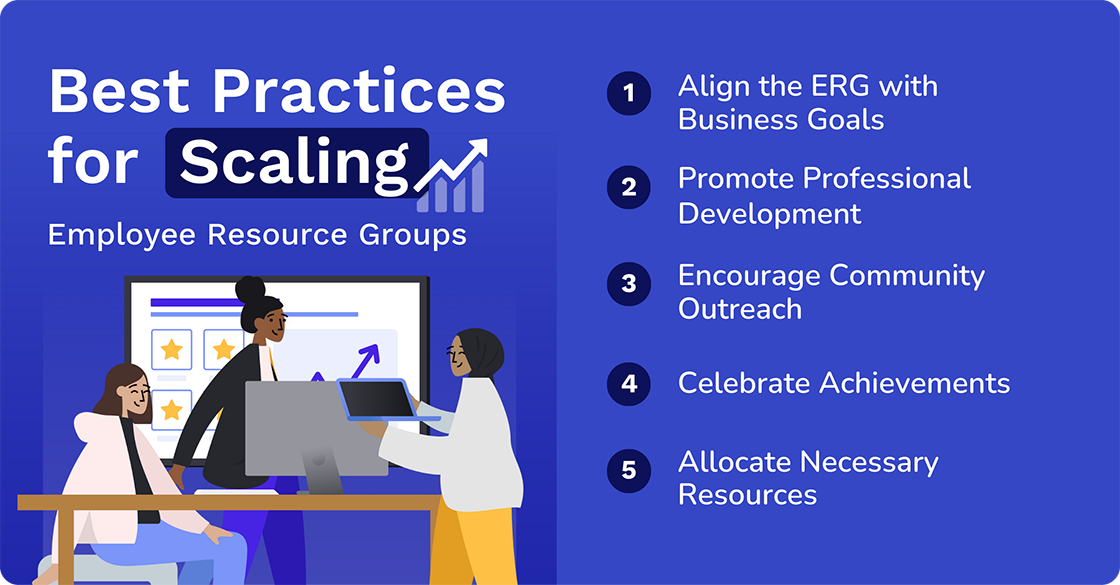
Employee resource groups rely on well-planned events to engage members, build community, and achieve their goals. But with so many possibilities, choosing the right event type can feel overwhelming. Here are some ideas and best practices to help in the selection of impactful and engaging events.
Start by considering your ERG's specific objectives. Are you aiming to foster professional development, create a sense of belonging, or raise awareness about a particular issue?
Gauge member interests. Conduct surveys, hold focus groups, or utilize online polls to understand what topics or activities resonate with your audience.
Don't be afraid to mix things up! Offer a diverse range of event types to cater to different learning styles and preferences. Consider options like:
Once you've chosen an event type, invest in thorough planning. Secure a venue, finalize details like speakers or catering, and establish a clear timeline.
Promote the event effectively. Utilize multiple channels like email, internal social media, and the ERG website to reach members. Create engaging descriptions that highlight the event's purpose and benefits.
Ensure your events are inclusive and accessible to all members. Consider factors like time zone differences for remote participants, dietary restrictions for food options, and accessibility needs for physical spaces.
Offer alternative formats like recordings or live transcripts for those who cannot attend in person.
Gather feedback from attendees through surveys or post-event discussions. This helps you understand what worked well and identify areas for improvement for future events.
Regularly evaluate the effectiveness of your ERG events. Track participation rates, member satisfaction, and the impact on achieving your ERG goals.
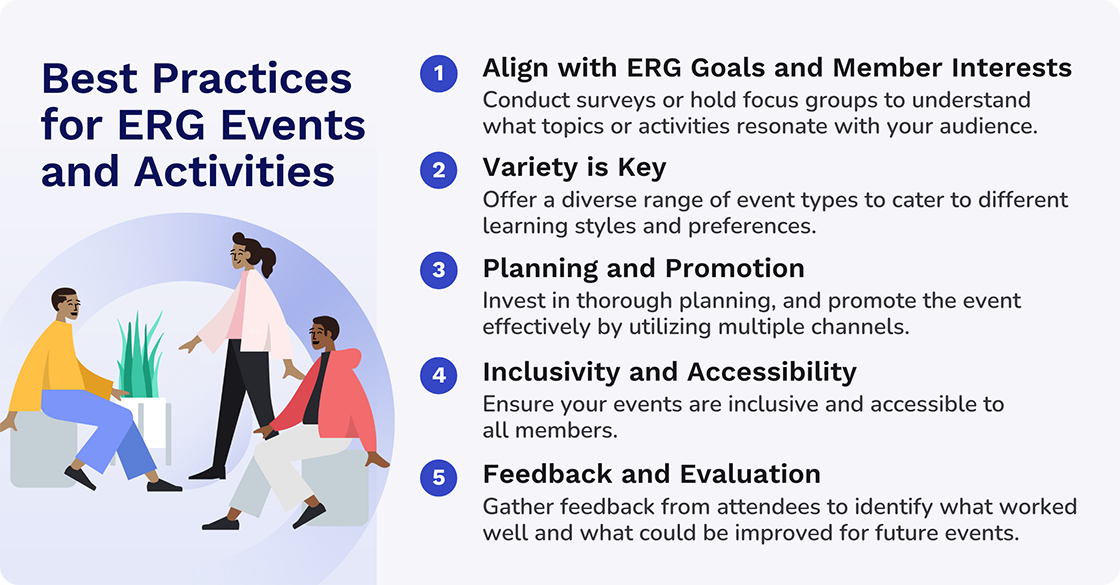
Effective communication is essential for ERG success. By maintaining open and consistent channels of communication and personalizing content to meet the diverse needs and interests of members, you will foster a strong sense of community and encourage active participation. This helps build engagement, strengthens member connections, and ensures everyone feels valued and informed.
Cerkl Broadcast is designed to help internal communicators make more meaningful connections with employees. It is a versatile platform with a centralized hub that can be used for all internal communication assets. A primary feature is the ability of Broadcast to enable delivery of relevant content that increases employee engagement and improves productivity.
This personalization feature works particularly well for ERG content. Employees can explicitly choose ERGs that they're interested in hearing about. Then, internal communicators can create additional categories in Broadcast or allow ERG leaders to be "authors" in Broadcast. This has another positive spinoff. It allows communicators to learn which ERGs employees are interested in through their engagement. In this way, Broadcast can help communicators get the ERG content to the right audiences.
We’ve spoken about the importance of diversity, equity, and inclusion. Broadcast is also a very effective tool for DEI initiatives that help to create a more-connected workforce.
Now is a good time to determine just how well your company values align with its diversity, equity, and inclusion (DEI) goals. Our 4-step checklist provides opportunities for feedback so you can communicate with employees and leadership to gauge their opinions.
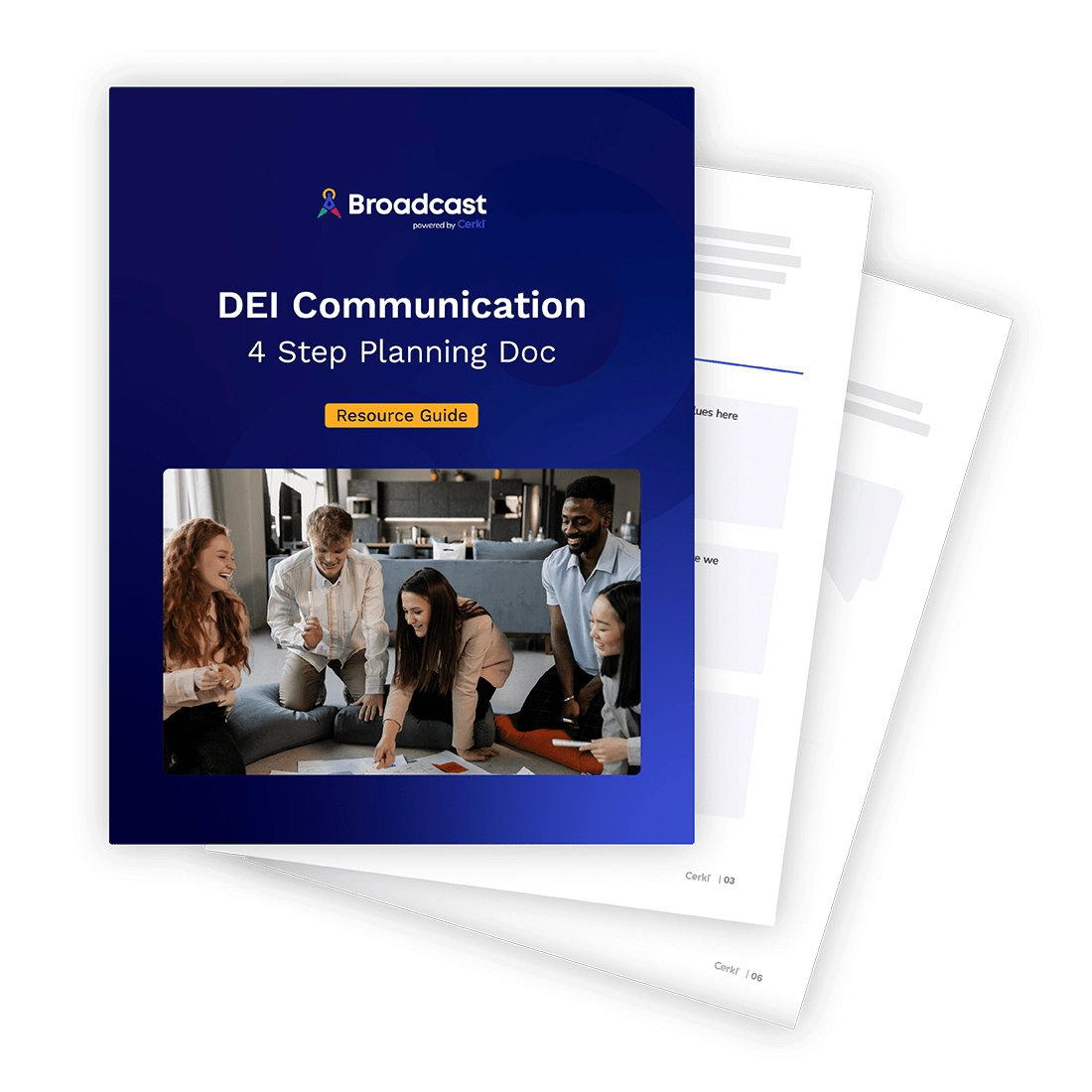
Ensure your company's communications promote diversity, equity, and inclusion
What are the best practices for creating employee resource groups? Identify employee needs and interests to determine ERG focus areas. Secure executive sponsorship, provide clear guidelines and support for ERG leaders, and foster collaboration between different ERGs.
What are the best practices for managing employee resource groups? Establish clear goals and objectives for each ERG. Provide adequate resources and support, facilitate effective communication between ERG leaders and management, and measure ERG impact and ROI.
What are the best practices for scaling employee resource groups? Ensure consistency in ERG structure and processes across different locations. Foster collaboration between ERGs, provide centralized support and resources, and measure the impact of ERGs on a broader scale.

Ensure your company's communications promote diversity, equity, and inclusion